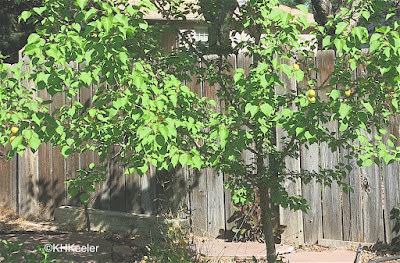 |
| One of my apricot trees: enlarge to more easily see the yellow fruits. |
Ten years ago, I admired a tree covered in apricots in Carbondale, Colorado:
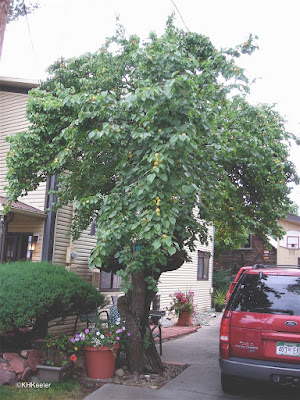 |
| The parent of my apricot trees |
I believed him but he gave me the fruits anyway. Since I had them, I planted them in my yard in Loveland, in groups of 4 or 5. Four young trees appeared. Today I have three trees, all 10' tall. All three have apricots on them this summer. I know there were a few fruits last year and maybe the year before, but this year I've picked 20 and there are more than that on the trees.
Apricots, Prunus armeniaca, are one of the many fruit trees in the rose family, Rosaceae. The genus Prunus includes plums, cherries, almonds and peaches--there are some 400 species of Prunus, most if not all with edible fruits. Apricot fruits are very similar in structure to their relatives, for example plums and cherries, just different in size and color. The common apricot, Prunus armeniaca, is the most widespread species but four or five other Prunus species are called apricots, for example the Japanese apricot, P. mume.
The common apricot has been in cultivation for easily 5,000 years (3000 BCE). Consequently its origins are unclear. Wild apricots, ancestors of the cultivated apricot, are today found only in Kazakhstan, Krygyzstan, Uzbekistan and the throughout mountains of western China. Domestication must have occurred in or near the native range, which is why botanists state that the Chinese first domesticated apricots. China claims a thousand varieties of apricot. Apricots can also be documented in India thousands of years ago. Furthermore, also very long ago, apricots arrived in Armenia where they were widely grown. Europeans discovered them in Armenia, leading to the idea that they were domesticated in Armenia. The word armeniaca in the scientific name means "of Armenia" reflecting that belief in Europe when plant was named.
The English name apricot comes from the Portuguese albricoque or Spanish albaricoque, which are themselves derived from the Arabic name al-burqūq, likely meaning "early ripe." So probably apricots came to England from Iberia. The Oxford English Dictionary entry goes on to derive the Arabic name from the Greek name, so the travels of the plant, as judged by its common name, loop back to Armenia and India.
Likewise apricots entered the Americas multiple times. They were planted in the Caribbean, Mexico and South America by the Spaniards in the early 16th century. Spanish settlers took them to New Mexico and Texas but the first introduction to the continental United States was in Spanish St. Augustine, Florida in the late 1500s. The University of California, Davis gives different story, saying apricots were first introduced to Virginia (about 1720) but "were not successful" until introduced to the California Missions (before 1795). I think this says a lot about how we report the history of the Americas--we talk a lot about Virginia (founded 1607) and New England (1620), but St. Augustine was established in 1565 and the New Mexico settlements date back to 1598. Politically an English focus makes sense, but for considering plant introductions it misses a lot. First apricots in an English settlement, Virginia; first to the United States, St. Augustine, first in the New World, sometime earlier, perhaps Cuba, Hispaniola or Puerto Rico before 1550.
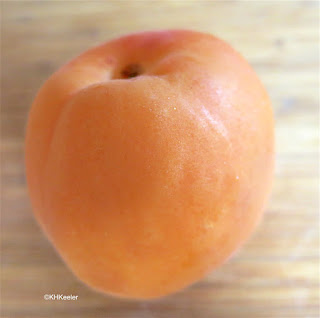 |
| commercial Colorado apricot |
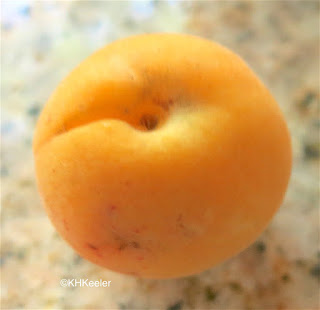 |
| One of my apricots, not even half the size of the commercial one |
 |
| Thorns on apricot tree |
As a teen, apricot jam was my favorite jam. Apricots cook well, fresh or dried, alone or in combination with other fruits, as pies and tarts and...whatever you are baking.
 |
| Interior of big comercial apricot...it was delicious |
Of course they've been fermented. You can make wine from apricots. Fermented and distilled they produce brandies (about link) or make an apricot-flavored liqueur when added to a distillate.
The liqueur Amaretto is flavored with oil of apricot seeds. The seeds--crack open the pit--are edible but contain enough cyanide, responsible for the almond-like flavor, that they should not be eaten in quantity. The seeds have a long history in producing an oil used in an array of medical, cosmetic and food applications (here's a list link--I don't know how effective some of these uses are).
I planted apricot pits because I had them. My garden design did not plan for apricot trees. But they grew, they are pretty trees with attractive spring flowers (link) and now, I have fruit to eat or cook with. How neat!
Comments and corrections welcome.
Note on names: Online, you can find wild apricots as Armeniaca vulgaris Lam. I have not found the technical paper that reclassifies them as Prunus armeniaca but undoubtedly all apricots, wild and domesticated, are Prunus armeniaca today. Very occasionally a domesticated plant is considered different enough from the wild ancestors to merit a different species, but not a different genus. In addition, Prunus, is a big genus including plums, cherries, almonds, peaches, sloes and about 400 others. Apricots hybridize with plums. That their ancestor is so different as to be classified in another genus does not make sense. And breaks at least one rule of modern taxonomy. Lam., who named Armeniaca vulgaris, is Jean-Baptiste Lamarck who lived 1744-1829. Most printed references to Armeniaca vulgaris are at least 80 years old. Those on the internet must not have checked carefully.
Collection of apricot folklore coming in the next few weeks.
Nice essay on other aspects of apricots from J. S. Denker's book The Carrot Purple, reported on The Salt, National Public Radio link
References
"apricot, n.". OED Online. June 2018. Oxford University Press. (accessed July 12, 2018).
Dunmire, W. W. 2004. Gardens of New Spain. University of Texas Press, Austin Texas.
Jillian, Kingsburg Orchards. 2013. The HIstory of the Apricot. link http://www.kingsburgorchards.com/apricot-history-blog
University of California, Davis. 2014. Fruit and Nut Eduction. link
Valder, P. 1999. The Garden Plants of China. Timber Press, Portland, Oregon.
van Wyck, B.-E. 2005. Food Plants of the World. Timber Press, Portland, Oregon.
If you haven't kept up with the internationalization of time reckoning, BCE = Before the Common Era, and CE = Common Era, which are set as the same dates as those counted BC Before Christ and AD Anno Domini (in the year of (our) lord). I'm inconsistent in my usage but prefer BCE/CE.
Kathy Keeler, A Wandering Botanist
More at awanderingbotanist.com
Join me on Facebook: https://www.facebook.com/AWanderingBotanist

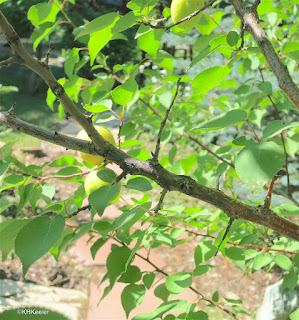
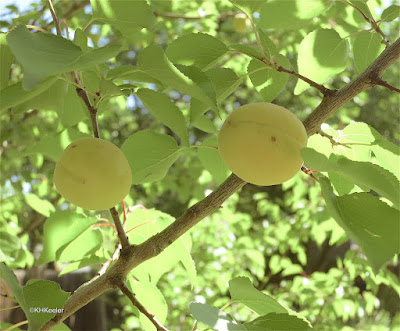
This comment has been removed by a blog administrator.
ReplyDeleteI have grown 4 Afghani Apricot trees from seeds (sweet kernel) inside dried apricots traditionally exported from Afghanistan and available as dried fruit in various overseas Afghan shops. I split the hard shell in a vice, wrapped the kernel in moistened paper towel, sealed in plastic bag and kept in the fridge around 4-5 deg. The seeds sprouted a long tail in a couple of months. I transferred the sprouted seed to a pot covering the seed just under the soil but leaving the long root far below in the soil. The plant grew vigorously. After a year or two I transplanted the plant into ground. In four years from seed, one tree is over 9 feet tall. No buds or fruit yet. The trees do have small thorn like branches. I also managed to graft them onto a standard Apricot tree and a peach tree.
ReplyDeleteDried apricots
ReplyDeleteThe benefits of nuts and dried fruits, if they are regularly included in our diet, help improve our health and prevent some disease....
Red apricots are a new variety of apricots developed from scientific methods. The color of the fruit is purplish-red with yellowish flesh present also. Juicy and fleshy fruit to eat is a source of many benefits. Deliciously cotton ish, sweet and sour in taste, they are apricots pollinated by plums. These red apricots are used with every type of cuisine. Salads, sandwiches, chicken, meat, mushrooms, etc.
ReplyDeletekashmir online store
Apricots are packed with essential nutrients, including dietary fiber, vitamin A, vitamin C, and potassium, contributing to their reputation as a healthy fruit.kashmir apricot
ReplyDeletegtrde
ReplyDelete